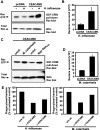Granulocyte CEACAM3 is a phagocytic receptor of the innate immune system that mediates recognition and elimination of human-specific pathogens
- PMID: 14707113
- PMCID: PMC1887732
- DOI: 10.1084/jem.20030204
Granulocyte CEACAM3 is a phagocytic receptor of the innate immune system that mediates recognition and elimination of human-specific pathogens
Abstract
Carcinoembryonic antigen-related cell adhesion molecules (CEACAMs) are used by several human pathogens to anchor themselves to or invade host cells. Interestingly, human granulocytes express a specific isoform, CEACAM3, that participates together with CEACAM1 and CEACAM6 in the recognition of CEACAM-binding microorganisms. Here we show that CEACAM3 can direct efficient, opsonin-independent phagocytosis of CEACAM-binding Neisseria, Moraxella, and Haemophilus species. CEACAM3- but not CEACAM6-mediated uptake is blocked by dominant-negative versions of the small GTPase Rac. Moreover, CEACAM3 engagement triggers membrane recruitment and increased GTP loading of Rac that are not observed upon bacterial binding to CEACAM6. Internalization and Rac stimulation are also inhibited by compromising the integrity of an immunoreceptor tyrosine-based activation motif (ITAM)-like sequence in the cytoplasmic tail of CEACAM3 or by interference with Src family protein tyrosine kinases that phosphorylate CEACAM3. In contrast to interfering with CEACAM6, blockage of CEACAM3-mediated events reduces the ability of primary human granulocytes to internalize and eliminate CEACAM-binding bacteria, indicating an important role of CEACAM3 in the control of human-specific pathogens by the innate immune system.
Figures










References
-
- Ryan, K.J. 1990. Neisseria including Branhamella. Medical Microbiology—An Introduction to Infectious Diseases. J.C. Sheris, editor. Elsevier Science Publishing Co. Inc., New York/Amsterdam/ London. 343–356.
-
- Schmidt, K.A., H. Schneider, J.A. Lindstrom, J.W. Boslego, R.A. Warren, L. Van de Verg, C.D. Deal, J.B. McClain, and J.M. Griffiss. 2001. Experimental gonococcal urethritis and reinfection with homologous gonococci in male volunteers. Sex. Transm. Dis. 28:555–564. - PubMed
-
- Virji, M., K. Makepeace, D.J.P. Ferguson, and S.M. Watt. 1996. Carcinoembryonic antigens (CD66) on epithelial cells and neutrophils are receptors for Opa proteins of pathogenic Neisseriae. Mol. Microbiol. 22:941–950. - PubMed
Publication types
MeSH terms
Substances
LinkOut - more resources
Full Text Sources
Other Literature Sources
Molecular Biology Databases
Miscellaneous

